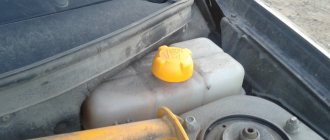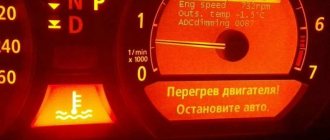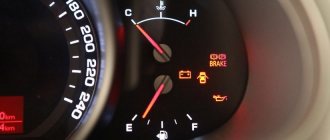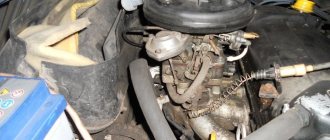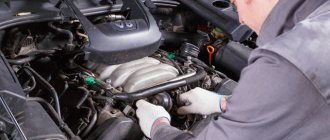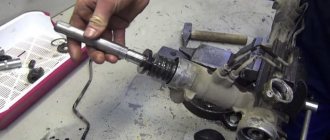Motor oil and coolant have different purposes and should not be mixed. However, sometimes antifreeze gets into the oil (and vice versa). Because of this, the motor begins to malfunction.
To prevent the negative consequences of antifreeze getting into the oil by identifying the problem in a timely manner, you need to understand what the signs of the presence of coolant in the lubricant are.
Signs of antifreeze or antifreeze in oil
Determining the presence of antifreeze or antifreeze in the oil will not be difficult. For example, a car owner may notice a significant decrease in the level of antifreeze, up to serious overheating of the engine.
If the oil contains antifreeze or antifreeze, it will begin to foam strongly, and foreign veins and inclusions will appear. The lubricant becomes rusty, which is explained by oxidation of the oil when antifreeze or water gets into it.
A characteristic white coating may appear on the dipstick, and if you unscrew the filler cap, you may notice abundant white foam. This indicates a high content of antifreeze or antifreeze in the oil.
You can detect the presence of foreign impurities, antifreeze or antifreeze in the oil experimentally by draining about 200 grams of lubricant and boiling the liquid. Such hot oil will seem to shoot, which is explained by the rapid and sharp boiling of water and antifreeze. But if there are no foreign impurities in the oil, then the lubricant will simply smoke when heated.
Diagnostics
When the cylinder head gasket
(cylinder head) burns towards the engine compartment, the location of the leak of antifreeze or other liquid from the cooling system can be easily determined by the drip. This is provided that the engine is supervised and washed regularly.
Especially cultured drivers, in order to quickly identify leaks of various fluids circulating in the engine, paint it in heat-resistant silver and regularly wash the engine itself.
On silver, all leaks are detected instantly, which allows you to quickly eliminate the problem. Of course, it is impossible to quickly determine anything on a dirty engine. But freshly squeezing antifreeze out from under the head there is a chance to see it.
A gradual decrease in the volume of antifreeze is not scary, and may indicate the presence of a breakdown in the gasket
, as well as for leaks in the main line connection bridges or microcracks in the hoses. An exchange of antifreeze and oil can also occur in the heat exchanger due to a leak in the seal.
When the issue concerns only antifreeze, its timely detection of getting into the oil will not cause serious or irreversible processes with the rest of the engine systems.
The situation will be worse when the system contains not antifreeze, but antifreeze diluted with water. In this case, you can expect everything from the engine, including overheating and deformation of the cylinder head.
Causes of such problems
When operating a vehicle, the engine experiences increased load, and the trouble-free operation of the power unit will depend on the quality of the fuel, timely oil changes, and the presence or absence of various internal problems. There are many reasons why an engine can fail, which leads to coolant getting into the oil.
The most common cause is a leaky cylinder head. If such a leak occurred due to problems with the gasket, then we can say that the car owner escaped with a slight fright, and all repairs will consist only of replacing such a damaged gasket. It is much worse if cracks appear in the cylinder head, which leads to the need to grind them or replace the valve cover head.
The pipes are not sealed. The design of the engine is such that if the pipes are not sealed or damaged, coolant can enter the oil, which leads to similar problems. Repair in this case will consist of identifying problem areas and replacing damaged pipes.
Cracks in the engine jacket. Similar problems arise when the power unit overheats and loses its geometry. The repair will consist of complete replacement of damaged elements.
In rare cases, such foreign inclusions and water in the oil may form due to natural causes. For example, when using low-quality oil in the winter, when the temperature drops inside the engine, a small amount of water may appear, which completely disappears when the engine warms up, and no difficulties arise with the operation of the engines.
About the white coating on candles
If a white coating has formed on the spark plugs, the reasons may be different. First of all, this indicates problems with fuel quality. But if it is a rough white coating on the spark plugs, the reasons are due to overheating of the engine. Also, similar soot forms if:
- The spark plug is not suitable for this engine (by heat rating or other parameters).
- The inlet pipe is leaking. Here air will be taken in from outside.
- Poor ignition calibration.
- There are problems with the cooling system (for example, a faulty radiator).
Why is water or coolant in oil dangerous?
If water and coolant get into the lubricant, the density invariably increases, while the fluidity decreases, as a result of which the engine is poorly lubricated and increased wear occurs. As a rule, the piston pins, camshaft and crankshaft are affected. If the car owner, in the presence of such problems, does not repair the engine, this leads to complete failure of the power unit, which can no longer be restored.
The resulting emulsion can get into hard-to-reach cavities, where it will soon coke, which leads to the pistons getting stuck in the rings. It should be said that repairs in this case will be very difficult, since washing out such contaminants and coked oil will be problematic. It is necessary to completely open the engine, eliminate the cause of water getting into the oil, and also perform a complete cleaning of the engine.
If there is water in the oil, problems are observed in the operation of the piston group, which in turn leads to increased fuel consumption.
The coolant will go into the oil, and therefore certain difficulties will arise with cooling the engine. As a rule, this leads to an even greater aggravation of the problem, the geometry of the valve cover and engine jacket is disrupted, numerous cracks appear, and as a result, it is not possible to repair such an engine and the damaged motor has to be replaced.
Let's sum it up
So, we found out why antifreeze gets into the oil. As practice has shown, this problem can be identified in time by the car owner. The main signs are a characteristic white exhaust and a drop in the level of antifreeze in the tank. If liquid penetrates oil, the latter changes its structure. This is determined by the probe. In addition, suspicions may be reinforced by the wet electrode on the spark plugs and the characteristic sweet smell of antifreeze on them. We looked at the reasons for antifreeze in oil. You should not continue to operate such a car. This type of engine overheats easily. In addition, it will work with bad oil, which has lost all its positive properties. The cost of repairs will depend on the nature of the problem. This could be a gasket, head or block. In the latter case, the cost of rebuilding the engine will be the most significant.
How does lubricant get into antifreeze (antifreeze)?
The cooling system of the power unit is a network of channels passing through the block and cylinder head. It is sealed and therefore operates under pressure resulting from the heating and expansion of the liquid. The lubrication system has a similar structure, only the channels are narrower, and the pressure is created by an oil pump.
There are only 3 reasons why two different liquids are mixed:
- The gasket between the head and the cylinder block is the weak point of any engine. When the smallest crack appears in it, liquid with higher pressure penetrates into the “foreign” system. As a rule, oil enters the antifreeze because the oil pump “presses” harder than the pump. Although mutual penetration also happens.
- In cars with powerful and more complex engines, there is an element for cooling the engine lubricant - an oil cooler. In it, too, mixing of antifreeze and oil occurs as a result of a breakdown of the gasket.
- Cracks in the metal of the cylinder head itself.
Consequences of driving with a broken gasket
It is prohibited to operate a vehicle where antifreeze gets into the oil. What is the reason? The liquid itself, despite its toxicity, does not harm the engine. But the danger is posed by ethylene glycol, which is contained in the coolant. If it mixes with oil, the result is abrasive particles. Because of this, there is a risk of scoring.
What happens when antifreeze gets into the cylinder block? Then it interacts with the oil, and deposits are formed in the form of an emulsion. This leads to a decrease in the diameter of the channels. Lubricant and antifreeze are not able to circulate normally. As a result, the engine runs with insufficient oil pressure and overheats. The oil filter also becomes significantly dirty.
The oil itself, diluted with coolant, loses its lubricating and protective properties. This reduces the resource of the internal combustion engine and threatens high repair costs.
Fault detection
This problem, or rather, a serious breakdown, is quite insidious and does not appear immediately. Liquid lubricant passes through microcracks in small portions, without having a particular effect on the operation of the power unit. Changes become noticeable at the next stage, when the channel connecting the two systems expands and the mixing speed increases.
How to determine whether lubricant has gotten into antifreeze:
- due to the deterioration of the cooling properties of antifreeze, the engine begins to heat up more often, the electric fan operates more often;
- the oil level gradually decreases, and the antifreeze level increases (it’s quite difficult to notice);
- the pump impeller whips up the oil-water mixture, turning it into a thick white emulsion that clogs the filter, causing the engine lubricant pressure to drop;
- drips are visible on the outside of the block or heat exchanger body, originating near the gasket (they do not always appear);
- the oil in the expansion tank changes the color and consistency of the coolant.
Important! The most obvious sign of mixing, monitored visually, is a white emulsion in the expansion tank with antifreeze. If you find a similar substance in the tank, compare this fact with other symptoms - constant overheating of the engine and signals from the oil level warning lamp.
As a rule, trouble does not come alone. Antifreeze that gets into the oil pan can create serious problems: at best, the emulsion will clog the lubricating channels and filter. In the worst case scenario, the crankshaft will rotate the bearings (sliding bearings) as a result of oil starvation. Expensive repairs are guaranteed.
Often the gasket bursts all the way to the cylinder walls, after which antifreeze gets into the combustion chambers (its channels are closer). The sign of a breakdown is clearly visible - white smoke pours out of the exhaust pipe in large quantities, and the engine power drops sharply.
When a similar problem occurs on a machine equipped with a heat exchanger - a motor lubricant cooler, diagnostic difficulties arise. If there are no external signs in the form of drips, then after identifying the emulsion in the expansion tank, it is better to contact a car service center. There, both units will be purged with a special installation and the culprit will be determined by air leakage.
What actions should I take?
First of all, find out why antifreeze began to leak into the car oil (how to find out the reason was written above). In most cases, you need to change the lining by checking the engine parts. If the block head is in good condition and has no noticeable cracks or holes, then repairs will not be expensive. If there is severe deformation, the worn part will need to be replaced. Remember that there is no point in repairing a broken block head. It's easier to replace it with another one.
Once you have eliminated the root cause, flush the cooling and lubrication system completely. You will need to disassemble the pipes and clean the oil channels. It's quite difficult. The mixture of coolant and lubricant is not easy to remove from parts. Use cleaning products that clean the engine from various contaminants.
Curdled oil in antifreeze negatively affects engine performance. Bearings become coked, lubricant is deposited on spare parts, and the corrosive effect increases. If you ignore the problem, the power unit will jam and major repairs will be required.
When purchasing a vehicle, be prepared for the fact that you will need to carry out maintenance yourself. All recommendations are written in the operating manual. Once you understand how a car works, you are unlikely to pour antifreeze into the lubricant complex.
Such knowledge comes with experience. The more experienced the driver, the more procedures he can perform independently. This makes it possible to save your own money, since you do not need to pay car service employees for work.
To ensure that your vehicle serves you for as long as possible, follow the recommendations prescribed by the car manufacturer in the owner's manual. Fill the engine with only those consumables that are optimal for your power unit. If you find it difficult to choose the optimal cooler/oil, contact an experienced driver or a service center employee. Proper car maintenance is a guarantee of long-term operation of the car.
Elimination method
When a significant amount of lubricant gets into the antifreeze, the latter is unable to work as a coolant. It forms clots and even solid particles that settle on the walls of the channels, clogging the thermostat valve and clogging the radiator. There is also no guarantee that mutual penetration has not occurred and antifreeze has not leaked into the oil pan. Hence the conclusion: both liquids must be drained .
If your car is equipped with an oil cooler, immediately contact a service station to locate the broken gasket. Then decide whether to carry out the repairs yourself or entrust the work to car service personnel.
What to do if oil or emulsion is found in the expansion tank with antifreeze:
- Both systems need to be flushed. Before draining the antifreeze, add a special detergent composition to the expansion tank and let the engine idle for 5 minutes. Empty the lubrication system immediately.
- Unscrew and discard the oil filter.
- Replace the gasket on the cylinder block by removing the cylinder head. During the dismantling process, disassemble the elements of the cooling system (pipes, pump, thermostat) and thoroughly rinse them by hand. Do the same with the heat exchanger if it is the culprit for mixing liquids.
- Unscrew the oil pan and oil pump, disassemble the latter and change all gaskets. Before assembly, wash the parts with gasoline or solvent.
- Assemble the power unit, install a new filter and fill in engine flushing lubricant. Instead of antifreeze, fill the system with distilled water and add detergent.
- Start the engine and let it run for 10–15 minutes without increasing the speed. Keep an eye on the oil warning light and temperature gauge.
- When finished, replace the water with a working fluid - antifreeze, and the flushing oil - with full-fledged engine oil. It is highly advisable to change the filter twice.
Advice. When pre-flushing the cooling system before eliminating the malfunction, monitor the temperature and pressure of the lubricant. If you notice something is wrong, immediately turn off the engine, as the oil still gets into the antifreeze.
No matter how carefully you try to wash the engine parts during disassembly, you will not be able to get to all the channels. Therefore, flushing is performed several times, including after starting the power unit. During further operation, monitor the condition of the process fluids so that the problem does not recur.
What to do
The method for eliminating an antifreeze leak depends on the cause of its occurrence. The simplest situation is a burnout or rupture of the gasket. It cannot be repaired, so the gasket should be replaced.
If a deformation of the cylinder head occurs, most often you cannot do without the help of a specialist, since performing this action incorrectly will lead to failure of the part. A deformed cylinder head will require grinding on a special machine. But if the defects are serious, it is necessary to remove more than the permissible layer. In this case, the part will have to be replaced.
The discovery of a large crack in the cylinder block requires its immediate replacement. Small cracks in cast iron or silumin blocks can be repaired by welding - electric or “cold”.
